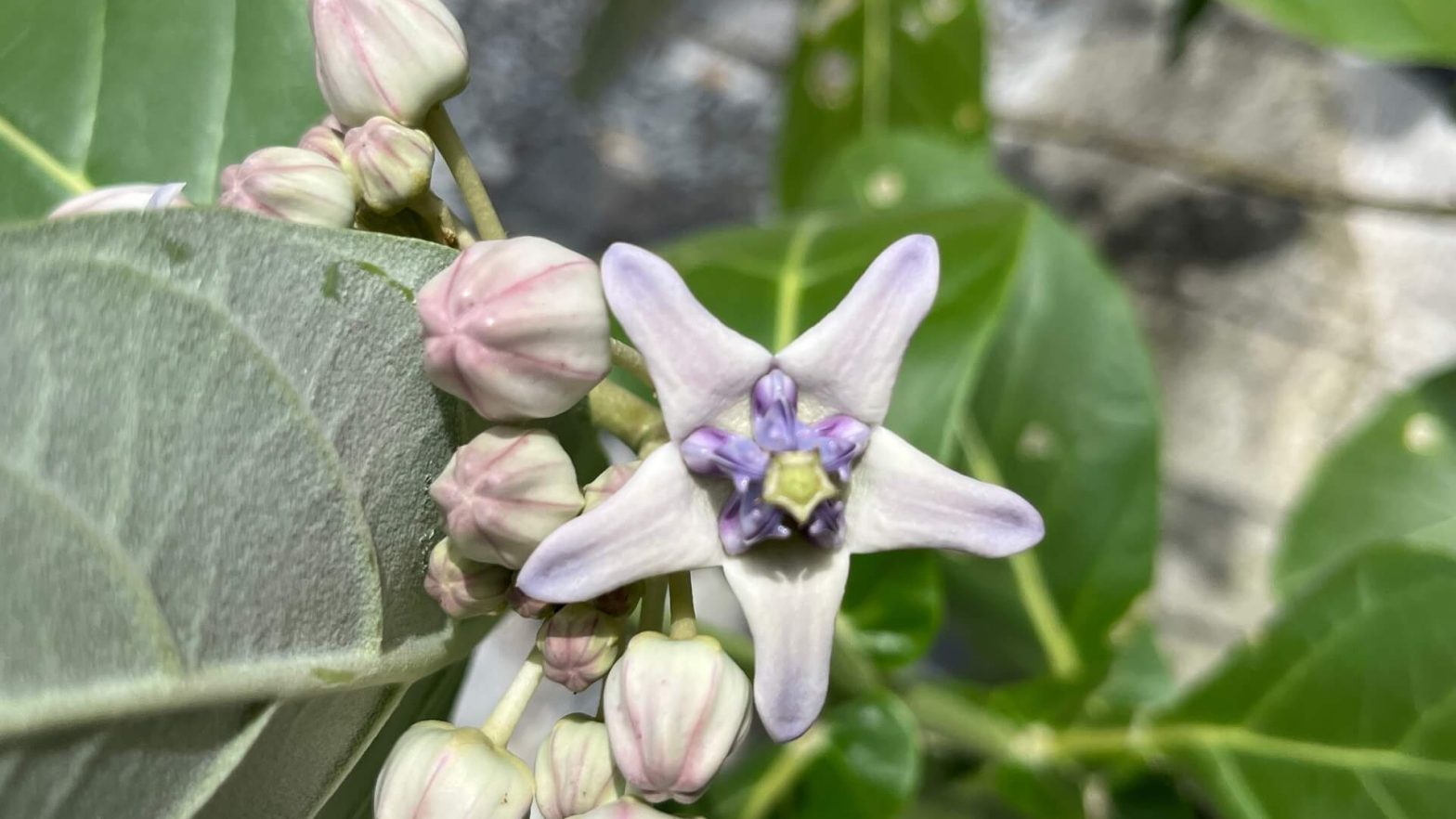Calotropis popularly known as Aak, Mandar or Rui in India is the flower of choice as an offering to the deity Hanuman. Hanuman is the son of Vayu-Wind God and represents Praan or Life Force. Aak leaves are known to pacify Vata dosha. This dosha is a combination of the air and space elements. It is not a surprise that the leaves of Aak are known for their healing effect on stiff joints and muscles. Wrestlers and bodybuilders in India especially worship Hanuman. As they ask for His blessings of courage and strength, they improve their own health by following the practices around His worship. It is amazing to learn about the deeply scientific thinking in Bharatiya tradition and culture.
The Sanskrit name of this Ayurvedic herb with miraculous healing capabilities is Arka, which means ‘a flash of light’, and is a synonym for the Sun. Similar to the sun the Aak plant is very strong, astringent, hot in veerya (potency) and has the ability to draw out moisture from swellings. This plant occupies a special relevance in sun worshipping ceremonies too.
The Latin name for Aak is Calotropis gigantea. It is also commonly known as the crown flower. The leaves, the stem, flowers and roots of this plant are used as medicines. The plant has a milky latex which is sharp in nature and can cause irritation in sensitive individuals It is an emetic as well as a purgative. There are two varieties of this plant either with white flowers (this is more medicinal) or with lavender coloured flowers. It’s fruit pod is filled with soft, silky cotton fibres that are specially used in auspicious rituals for making wicks fire lamps used in the worship of the Sun. The wood is also used as sameedha in the Surya yadnya.
Traditionally, the herb is known for its magical healing ability. In tribal communities it is common to revere the tree. They tie a leaf of the Aak tree on the head of pregnant mother to facilitate easy delivery. It is also believed that pressing Aak leaves on the soles of the feet for a few days, (by wearing socks over them) reduces the blood sugar levels in diabetics.
In Ayurveda, the herb is known for relieving respiratory, digestive and joint related complaints. It is also known to reduce swellings and growths. Below are some of its more popular home remedies.
- Fomentation – To use the leaves for fonentation one first has to treat them in one of the following ways. Apply oil on the shiny surface of the Aak leaves and roast them on an iron pan on slow heat. Alternately, the oil leaf surface maybe placed on the affected area and kept warm with a hot water bottle on top. Fomentation of Aak leaves can be used in many ways.
- Foment the chest with 4-5 leaves gives quick relief in case of cough and cold.
- The same method gives relief in case of arthritic or rheumatic pain of joints specially knee joints.
- Aak leaves fomentation is known to give relief in case of enlargement of liver and spleen. The best way to do this is to soak a cotton cloth in heated cow urine, use this to wrap a Aak leaf and then foment.
- In case of swelling on the feet or ankles, place warm leaves and wrapped in a with a cloth gives relief.
When children get bloating in the abdomen along with pain it can be relieved by applying a coconut based oil like Rose Beauty onAak and using them for fomentation.
- Quick relief in case of an asthma attack – apply sesame oil or Abhyanga oil on the chest and with Aak leaves.
- Dhoop therapy: Suitable for children and adults with a tendency to catch frequent coughs or asthma. Inhale the smoke or dhoop of the dried root of Aak to increase immunity.
- For managing swellings: make a decoction of the Aak root in the following way.Ingredients – Bark of the root of Aak 5 gm, triphala 5 gm and half litre of water. Boil these together until it reduces to 1/8th of the original volume. is boiled till1/8 quantity remains and filter it. When it becomes lukewarm, add half a teaspoon if honey and 1 teaspoon of stone sugar. Taking this decoction regularly gives immense relief in all types of swellings. In addition, a lep (paste) of rui leaves maybe applied externally on the swelling for greater relief.
- Corns and callouses – The milky sap of Aak should be applied in a continuously to get rid of corns and callouses. way in the callous to
- Herbal Tea – The flowers are used as part of herbal tea blends for digestive ailments and for diabetics.
All in all, Aak is a powerful herb that can help manage some chronic Vata dosha related problems and is a plant that offers every one of its parts as medicine to us. Easy to use and fragrant, the Calatropis or Aak plant can really add great solutions to your own personal health practice.
